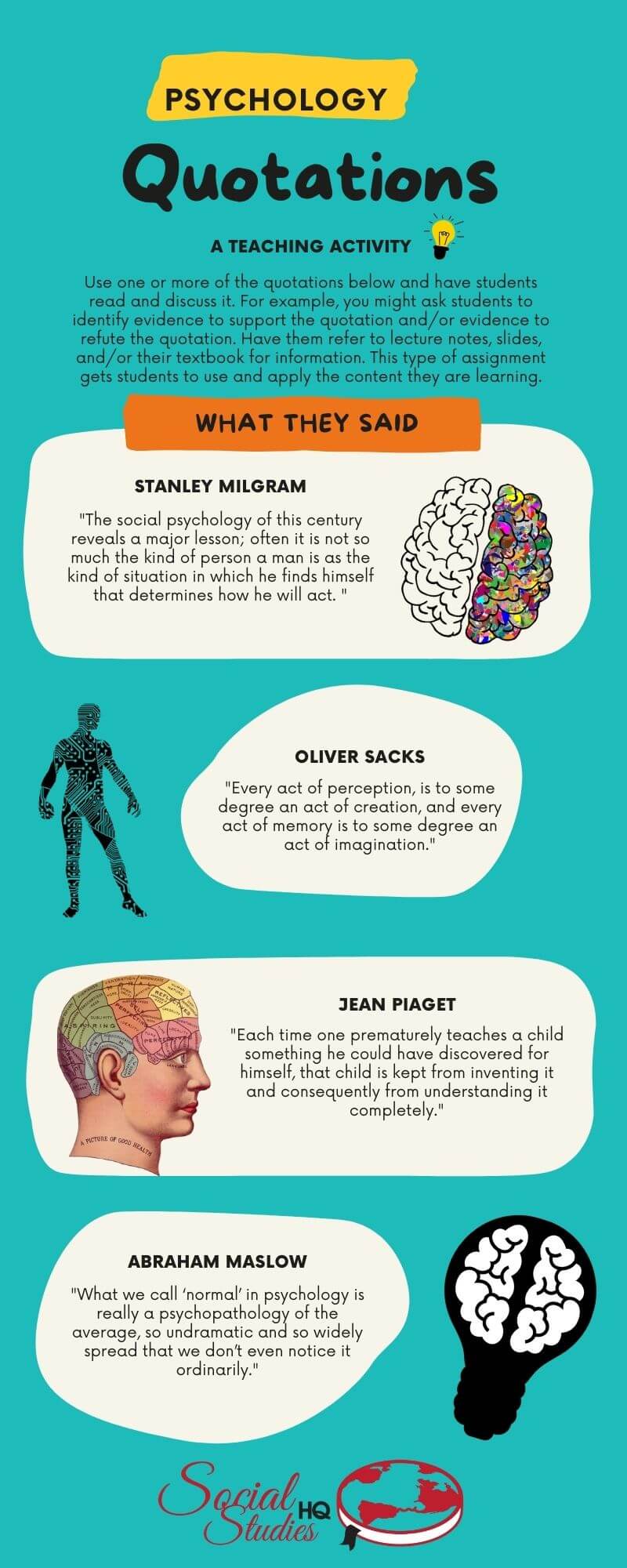- Social Studies
- Social Studies Activities
- Psychology Activities
7 Psychology Activities for Teaching the Introductory Course
Creating psychology activities to teach an introductory course can be a joy, but it can also be a challenge. Basically the course is a survey of the entire field of psychology (often in 18 weeks or less). To keep students interested, the instructor needs a wide variety of activities.
Here are a few psychology activities that can be used with a variety of different topics. I like to use these kinds of activities to get students into the content and talking about it. Most of these activities have either no grade (an in class exercise) or a minor grade (just to keep students motivated and working). I like to do these kinds of things so that students have something to talk about and also maybe some questions about the material were are studying this week. These activities are flexible enough that they can be done by students individually or by a group of students working together.
Top 5 or Top 10 List
Psychology activities don't have to be complicated. Here is an easy to do activity. Ask students to identify the 5 most important . . . Justify your choices. Discuss and compare lists as a class. For example, the 5 most important vocabulary words for understanding sensation and perception. Or the 10 most important ideas we have discussed in introductory psychology this semester. This is a great review activity for a semester exam. Students can work in groups during class to develop a list for 15-20 minutes. Then groups can present and defend their lists to the class. Comparing the work of different groups can also make for interesting discussion.
Acrostic
Create an acrostic from an important word and then create sentences for each letter about the topic. This can be done superficially, so you may want to add some level of challenge. For example: Create an acrostic using the word learning. Be sure to incorporate all of the major learning theories identified in your textbook chapter (lecture notes). You should also create a sentence for each letter that provides a brief but accurate summary of what this theory says about how learning happens.
Debate
Create a debate proposition, organize students into teams, give them 15 minutes to research and prepare, and then have an informal debate. For example: behaviorism is a more valuable approach for understanding psychological behavior than the psychodynamic perspective. You will want to debrief students after such a debate to remind them that the purpose of this kind of assignment is to bring out some of the more important aspects of each topic not to select a winner.
Fact Sheet
Some psychology activities require a little more preparation by the instructor. This activity is great, but it benefits from taking some time to think through the details of what you want the students to do. Create a fact sheet about a topic (1 page handout or 2 page handout) that highlights the most important information about . . . Give students a specific audience for the information as well. For example: create a fact sheet that explains the following major types therapy: Psychoanalytic, Behavioral, Cognitive, Humanistic/client-centered, and Humanistic/Gestalt therapy. Write this fact sheet as a handout for a therapist to provide to his patients. In other words, you need to be factually accurate, but you also need to write this information for someone who may know little or nothing about psychology. Be sure to cite references in APA format for your information. Put your references list on a separate page. A variation of this activity to be done during a class period might involve having a group of students work together and use markers and chart paper to create a bulleted list of important points. Give the groups a time limit, and then have them present to the class. You could then allow groups to explain in more detail the bullet points they created.
Race to the Board
This is an “old fashioned” review activity, but it still works just fine. Divide the class into teams; have the teams line up and then send the first person to the board to answer a question. You ask a question and the first team to write correct answer gets a point; you can just create questions on the fly from lecture notes, slides etc. Whenever you decide you have asked an adequate number of questions, announce last question and then declare a winner. If questions stump everyone, you can review on the spot to help everyone understand content they have missed or misunderstood.
Hypothetical Situations
Create a hypothetical situation related to your current psychology content. Have students write a one page paper; students can bring the paper to class to share and discuss. If you want, you can collect and skim over the papers as a formative assessment. There is no need to spend a lot of time reading and grading these papers in detail. They are practice exercises to get students thinking about the content. Here are a couple examples:
Suppose you are a psychological researcher and want to study the relationship between adolescent texting and school grades. Which research methodology might you choose? Why? Briefly outline the research process you might use for this hypothetical experiment using information in your textbook to help you.
Every child should be required to take an intelligence test upon entering school and should be tracked based on the results. Children with high scores should be on a college preparatory track and children with low schools should be on a vocational track that prepares them to enter the work force immediately after high school graduation. Present an argument that supports, rejects, or modifies this thesis, and support your response with factual evidence.
Film Analysis
Select a film for the class to watch; then require students to apply psychological principles to the film; or allow students to select a film of their choosing and then apply psychological principles to the film This would also work with film clips from YouTube. Using film clips is a handy strategy if you want to avoid the time that a full length film requires. I have had success using the films Temple Grandin and Awakenings. This strategy can be used for a variety of psychology activities. Students could have a group discussion after watching a film and share out with the class, or you could require students to write a paper analyzing a film using one or more psychological principles.
Psychology Activities by Topic
If you want psychology activities that are geared to specific topics in the introductory psychology course, a great resource is Teachers of Psychology in Secondary School (TOPSS) Classroom Activities. These activities do not cover every topic in the introductory course, but there are some really great teaching strategies and activities for several areas.
You might also want to check out the NOBA Project. This site has psychology activities and materials for teaching a full introductory course in psychology. In fact, you will need to pick and choose which materials to use as they offer more than you could possibly cover in a single course. Each section of these materials has been written by experts in that particular field or area. This makes it a very accurate and engaging set of materials for use in the classroom.
Teaching psychology can be a challenge, but with these psychology activities and ideas you'll have plenty of resources to help your students understand the field.
 Here is an easy to do psychology activity that students could do individually or work on in groups. Perhaps you could assign a different quotation to each group. Groups could report out to the class about their discussion.
Here is an easy to do psychology activity that students could do individually or work on in groups. Perhaps you could assign a different quotation to each group. Groups could report out to the class about their discussion.What's Your Favorite Psychology Activity Idea?
Have a great psychology activity idea that has worked for you? Something you use in your introductory psychology course? Share it!

